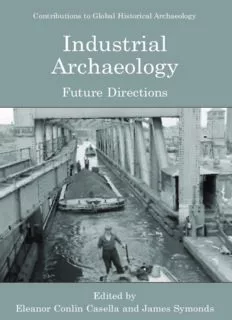
Industrial Archaeology: Future Directions PDF
Preview Industrial Archaeology: Future Directions
Contributions to Global Historical Archaeology Industrial Archaeology Future Directions Edited by Eleanor Conlin Casella and James Symonds Industrial Archaeology Future Directions Industrial Archaeology Future Directions Edited by Eleanor Conlin Casella UniversityofManchester,Manchester,UnitedKingdom and James Symonds Director,ARCUS,GraduateSchoolofArchaeology, Sheffield,UnitedKingdom with the support of E N G L I S H H E R I TA G E LibraryofCongressCataloging-in-PublicationData LibraryofCongressCataloging-in-PublicationData AC.I.P.CataloguerecordforthisbookisavailablefromtheLibraryofCongress. ISBN0-387-22608-7(hardbound); 0-387-22808-X(paperback); e-ISBN0-387-22831-4 Printedonacid-freepaper. (cid:1)C 2005SpringerScience+BusinessMedia,Inc. Allrightsreserved.Thisworkmaynotbetranslatedorcopiedinwholeorin partwithoutthewrittenpermissionofthepublisher(SpringerScience+Business Media,Inc.,233SpringStreet,NewYork,NY10013,USA),exceptforbrief excerptsinconnectionwithreviewsorscholarlyanalysis.Useinconnection withanyformofinformationstorageandretrieval,electronicadaptation, computersoftware,orbysimilarordissimilarmethodologynowknowor hereafterdevelopedisforbidden. Theuseinthispublicationoftradenames,trademarks,servicemarksandsimilar terms,evenifthearenotidentifiedassuch,isnottobetakenasanexpressionof opinionastowhetherornottheyaresubjecttoproprietaryrights. PrintedintheUnitedStatesofAmerica (SBA/TB) 9 8 7 6 5 4 3 2 1 springeronline.com Contents NewDirectionsinIndustrialArchaeology ........................ ix SirNeilCossons,OBE Introduction ......................................................... xi EleanorConlinCasellaandJamesSymonds PartI. Re-thinkingIndustrialArchaeology CHAPTER1. “SocialWorkers”:NewDirectionsin IndustrialArchaeology ......................................... 3 EleanorConlinCasella CHAPTER2. ExperiencingIndustry:BeyondMachinesand theHistoryofTechnology ...................................... 33 JamesSymonds CHAPTER3. IndustrialArchaeology:ConstructingaFramework ofInference ..................................................... 59 MarilynPalmer CHAPTER4. AfterIndustrialArchaeology? ........................ 77 DavidCranstone PartII. TheConservationofIndustrialMonuments andLandscapes CHAPTER5. FromValvestoValues:IndustrialArchaeology andHeritagePractice ......................................... 95 KateClark v vi Contents CHAPTER6. PublishingandPriorityinIndustrial Archaeology ..................................................... 121 DavidGwyn CHAPTER7. GasandGrain:TheConservationofNetworked IndustrialLandscapes ......................................... 135 DavidWorth CHAPTER8. ExploringMrs.Gaskell’sLegacy:Competing ConstructionsoftheIndustrialHistoricEnvironment inEngland’sNorthwest ........................................ 155 MalcolmA.Cooper PartIII. ArchaeologiesoftheFactoryandMine CHAPTER9. TheSocialArchaeologyofIndustrialisation: TheExampleofManchesterDuringthe17th and 18th Centuries .................................................. 177 MichaelNevell CHAPTER10. TechnologicalInnovationintheEarly 19th CenturyIrishCottonIndustry:OvertonCottonMills, CountyCork—ThomasCheekHewesandtheOriginsofthe SuspensionWaterwheel ........................................ 205 ColinRynne CHAPTER11. BuildingaWorking-ClassArchaeology: TheColoradoCoalFieldWarProject .......................... 217 RandallH.McGuireandPaulReckner CHAPTER12. CulturalIdentityandtheConsumptionofIndustry 243 StephenA.Mrozowski CHAPTER13. TheIndustrialArchaeologyofEntertainment ...... 261 MartinHall Contents vii CHAPTER14. ColonisationintheIndustrialAge:TheLandscape oftheAustralianGoldRush ................................... 279 SusanLawrence Commentary ConcludingComments:RevolutionizingIndustrialArchaeology? 301 MaryC.Beaudry Index ................................................................ 315 New Directions in Industrial Archaeology Sir Neil Cossons, OBE Over the past 50 or so years the study of the industrial heritage has become one of the most vibrant and progressive areas of research and practice. This growth and consolidation can be seen across the devel- oping discipline, not least the range of academic courses, specialist publicationsandresearchprojects,allseekingtopromoteabetterun- derstanding of the historic industrial environment and its surviving remains. It reflects a growing realisation not only of the immense im- portanceofBritain’sroleasthefirstindustrialnationbutoftheextent and significance of the evidence all around us. And that recognition is now embracing the need for more than historical and archaeological knowledge. Today we have to engage knowledgeably and confidently with the change process in order to open eyes to opportunities for re- cycling buildings and whole landscapes back into new and productive useswhilesecuringtheirintegrityandtheirmeaninginthelandscape. Understandingthecomplexitiesofthishistoricindustrialenviron- ment is crucial if we are to develop a structure for its protection and management.Thisisparticularlysonow,fortheindustriallandscapeis under pressure as never before, from renewal and development, some ill-considered some thoughtful. Proper understanding can reduce the formerandensurethesuccessofthelatter. The nature and consequences of this pressure can be seen every- whereandnotonlyinurbanareas.Itcanbeseenwhereverregeneration programmeshaveledtomassiveandsustainedchange,andasmuchin thecountrysideasintownsandcities—inrurallandscapeswhichthem- selves sustained prolific industrial activity in the past. Whether the adaptive reuse of a mill or factory, the wholesale removal of Victorian terracedhousing,radicalchangestothetransportinfrastructureorthe restructuringoftheruraleconomy,thespeedandscaleofthistransfor- mationposeshugechallengesforus. Sir Neil Cossons, OBE • Chairman of English Heritage, English Heritage, London W1S2ET,UnitedKingdom ix x SirNeilCossons,OBE Here and there, change will result in removal for preservation in amuseumsuchastheManchesterMuseumofScienceandIndustryor sometimes in-situ as part of a project like Ironbridge. Or, the value of thelandscapemaybesuchthatWorldHeritagestatusisanappropri- atemeansofpreservation,promptingtheneedforthemostperceptive and measured of responses based on deep and thorough understand- ing. But for by far the majority of industrial buildings and structures, in city, town or countryside, the future will depend on new, appropri- ateandimaginativeusesbeingfound.Thechallengehereistoachieve a use which secures the intrinsic character and quality of a building orstructure.Forthis,knowledgeandunderstandingareessential.But thisisonlythefirststep.Itmustleadinturntocarefullycrafteddesign briefsandmanagementframeworkswhichareflexibleenoughtoallow forbothpreservationandformanagedchange. I have spent much of my life involved in the conservation of the industrial heritage in some form or another. Throughout that time, I have been particularly struck by the importance of encouraging both researchinindustrialarchaeology,aswellashistoryanddevelopment ofappropriatemanagementregimes.Keytobothiswidespreadpublic acceptance,andthekeytothatisinformedandopendebate. I am especially pleased therefore that English Heritage has been abletosupportthepublicationofthisvolumewhicharoseoutofathe- matic session at the Theoretical Archaeology Group in 2002. That the conferencewasheldinManchesterisparticularlyfittinginthatthecity isbeingnominatedbytheBritishGovernmentasaWorldHeritageSite onthebasisofitspowerfulandpersuasiveclaimtobetheworld’sfirst industrial city. It is here also that some of the challenges of balancing regenerationandconservationareattheirmostcritical.Inspiredsolu- tionsthatreconcilethevoicesofthepastwiththeneedsofthepresent andouraspirationsforthefutureneedwisdomandcreativity,goodwill and ingenuity. I am certain that the papers in this book will advance the discussions over the nature of the industrial past and its role in allourfutures.AstheChairmanofEnglishHeritage,myinterestand optimism continues to grow. I very much hope that these papers will encourage the continuing debate which characterises such a vibrant andchallengingsubject. SirNeilCossons,OBE ChairmanofEnglishHeritage Introduction Eleanor Conlin Casella and James Symonds Theessaysinthisbookareadaptedfrompaperspresentedatthe24th Annual Conference of the Theoretical Archaeology Group, held at the University of Manchester, in December 2002. The conference session “An Industrial Revolution? Future Directions for Industrial Archae- ology,” was jointly devised by the editors, and sponsored by English Heritage, with the intention of gathering together leading industrial and historical archaeologists from around the world. Speakers were askedtoconsideraspectsofcontemporarytheoryandpractice,aswell as possible future directions for the study of industrialisation and in- dustrialsocieties. It perhaps fitting that this meeting was convened in Manchester, whichhasarichindustrialheritage,andhasrecentlybeenproclaimed asthe“archetype”cityoftheindustrialrevolution(McNeilandGeorge, 2002). However, just as Manchester is being transformed by regen- eration, shaking off many of the negative connotations associated withfactory-basedindustrialproduction,andremakingitselfasa21st centurycity,thensotoo,isthearchaeologicalstudyofindustrialisation beingtransformed. In the most recent overview of industrial archaeology in the UK, SirNeilCossonscautionedthatindustrialarchaeologyriskedbecoming a“onegenerationsubject”,thatstoodontheedgeofoblivion,alongside themid-20th centurypursuitoffolklifestudies(Cossons2000:13).Itis to be hoped that the papers in this volume demonstrate that this will notbethecase. Althoughtheconferencesessionuponwhichthisbookisbasedhad atheoreticalremit,itisinterestingtonotethattherangeofspeakers wentfarbeyondtheusuallistofcollegeprofessorsthatonemightexpect Eleanor Conlin Casella • School of Arts, Histories and Cultures University of Manchester,Manchester,M139PL,UnitedKingdom James Symonds • Executive Director, ARCUS, Graduate School of Archaeology, Sheffield,S14DT,UnitedKingdom xi
Description: